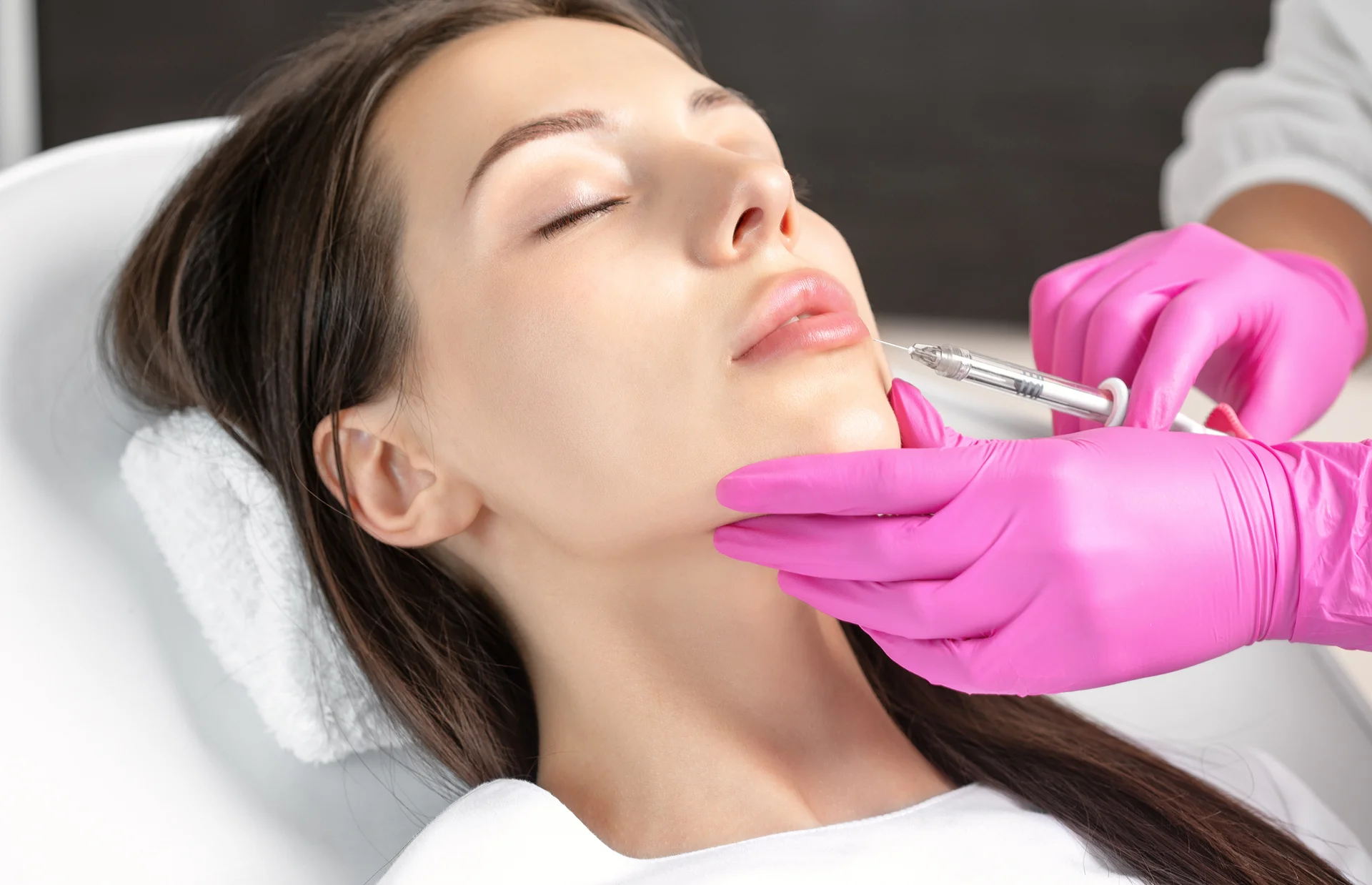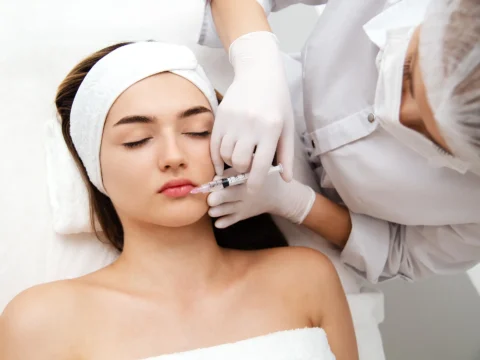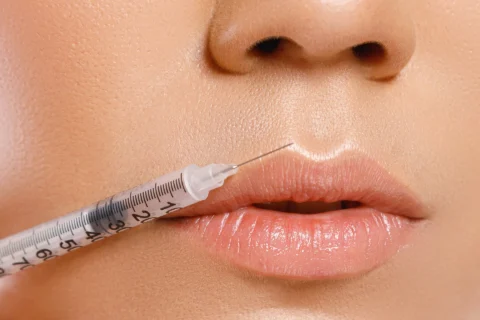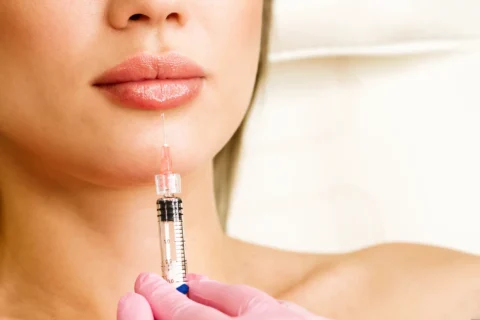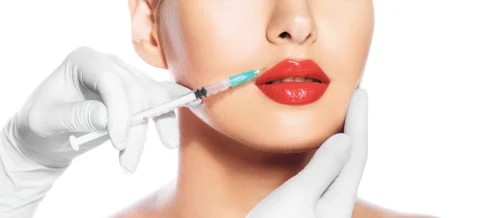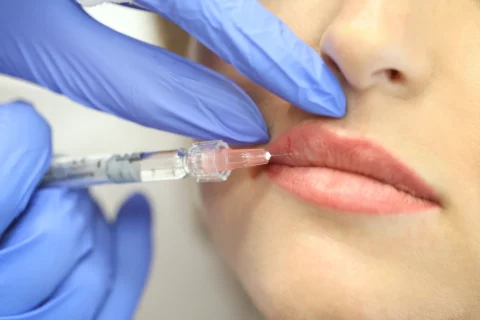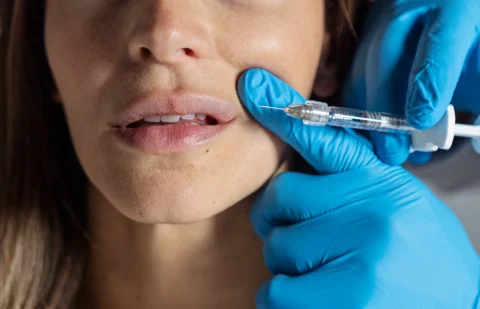Causes, Symptoms, and Treatments
Lip fillers like Juvederm and Restylane are popular injectable cosmetic treatments that can give you fuller, plumper lips. Although generally safe, some patients may experience an allergic reaction to the hyaluronic acid or lidocaine in the filler.
At Ethos Aesthetics + Wellness, Dr. Soni diagnoses and treats allergic reactions to ensure patient comfort and safety.
What Causes Allergic Reactions to Lip Fillers?
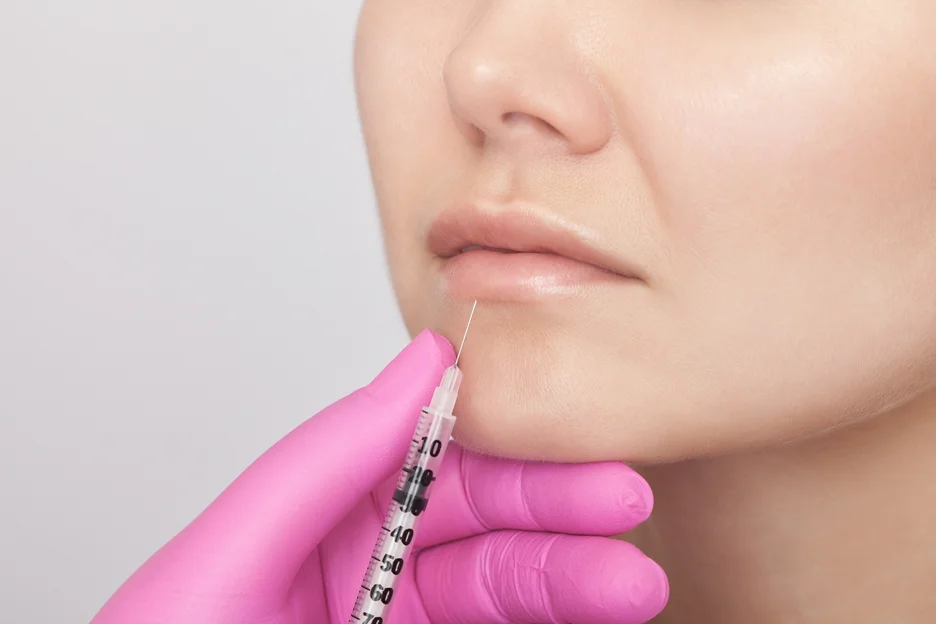
Lip fillers are gel-like substances injected under the skin to add volume and definition. Common injectable fillers include:
- Hyaluronic acid fillers – Juvederm, Restylane, and Perlane contain hyaluronic acid, a naturally occurring substance in skin that retains moisture and adds fullness.
- Collagen fillers – These contain bovine or human-derived collagen to plump lips. Examples are CosmoDerm, CosmoPlast, and Evolence.
- Synthetic fillers – Bellafill contains PMMA (polymethylmethacrylate) microspheres in collagen gel for longer-lasting augmentation.
Are There Allergenic Ingredients in Lip Fillers?
Yes, there is a risk of allergic reaction to ingredients in lip fillers. Common dermal fillers contain hyaluronic acid, which exists naturally in the body but some people may have allergies to. Other potential allergic reactions could be caused by preservatives or other ingredients.
Allergic reactions may occur due to:
- Hyaluronic acid allergy – Though rare, some patients are allergic to hyaluronic acid. Reactions are usually mild.
- Collagen allergy – More common bovine collagen allergies cause rash, itching, swelling. Human-derived collagen has lower allergy risk.
- Lidocaine allergy – Many fillers contain lidocaine, a numbing agent. Lidocaine allergies can cause hives, swelling, and anaphylaxis.
- Biofilm contaminants – Bacterial biofilm in the filler can trigger infection, swelling, and granulomas.
- Vascular occlusion – Compression of blood vessels may very rarely cause ischemic injury and tissue death.
Dr. Soni conducts a thorough health assessment and allergy test prior to lip injections to minimize adverse reactions.
Recognizing Symptoms of Allergic Reactions
Lip filler allergies can occur instantly or up to weeks later. Symptoms may include:
- Redness, swelling, itching at injection sites – Mild allergic reaction causes localized inflammation and irritation.
- Hives, wheezing, lightheadedness – Systemic allergic response with potentially serious anaphylaxis.
- Bruising and tenderness – Usually normal, but excessive bruising can signal vascular injury.
- Lumps, nodules, granulomas – Immune reaction to filler components creates inflamed lumps under skin.
- Discoloration, ulceration – Rarely, vascular occlusion reduces blood supply, causing tissue damage.
- Infection – Swelling, pus, fever indicate bacterial infection.
Contact our office immediately if you experience lip filler reactions. Dr. Soni will examine your symptoms and determine appropriate treatment. Delaying medical care can worsen outcomes.
What Are the Signs of Lip Filler Infection?
The main signs of lip filler infection include redness, pain, warmth, tenderness, and excessive swelling at the injection site. Other signs may include bleeding from the injection sites, swelling and bruising of the lips. It is important to see a doctor immediately if infection is suspected.
How To Treat Lip Filler Allergy?
For mild swelling, cold compresses and OTC antihistamines often provide relief. More severe reactions require prompt medical intervention:
- Steroid injections – Dr. Soni may inject corticosteroid medication directly into swollen areas to reduce inflammation.
- Hyaluronidase – This enzyme breaks down hyaluronic acid fillers. It can be injected to dissolve filler and reverse allergic reactions.
- Antibiotics – Prescription antibiotics treat bacterial infections. Oral and topical options are available.
- Anti-inflammatories – Oral steroids and NSAIDs like aspirin can treat swelling and discomfort.
- Surgery – Rarely, surgical excision is needed to remove granulomas or infected tissue.
- Hypermobile lip filler – In cases of vascular compromise, Dr. Soni injects hyaluronidase to liquefy filler and improve blood flow.
With prompt diagnosis and proper treatment, most lip filler allergies can be resolved with no permanent damage.
How Long Does It Take To Heal From Lip Filler?
It usually takes a week to heal from lip fillers. Swelling from lip fillers usually peaks within the first 24-48 hours. It may take up to a week for initial swelling to go down.
Swelling usually lasts up to 2 weeks. If swelling does not go down after 2 weeks, you should contact your doctor. It takes about 4 weeks for fillers to settle into the lips and achieve the final look.
Can I Get Lip Fillers if I Have Allergies?
It is possible to get lip fillers if you have allergies, but certain precautions should be taken. Patients with allergies to the main dermal filler ingredients like hyaluronic acid or lidocaine are not considered good candidates for fillers.
Prevention of Allergic Reactions
Dr. Soni takes proactive measures to avoid allergic responses:
- Thorough health screening for allergies, bleeding disorders, medications, and history of cold sores or herpes.
- Skin testing filler ingredients prior to injection, typically behind the ear.
- Using minimal effective filler amounts. Overcorrection raises complication risks.
- Avoiding vascular-rich areas like vermilion borders. Filler is injected slowly with minimal pressure.
- Applying ice before and after to constrict blood vessels and reduce swelling.
- Prescribing prophylactic antivirals for herpes-prone patients.
- Seamless hygiene protocols and sterile equipment to prevent bacterial contamination.
With careful injection techniques and testing, Dr. Soni ensures safe, aesthetically-pleasing lip augmentation results.
How To Prevent Lip Filler Side Effects?
To prevent lip filler side effects, you can do the following:
- Avoid strenuous activities and massaging/rubbing the treated area for the first 24 hours after treatment. This can help reduce swelling and bruising.
- Apply an ice pack wrapped in a thin towel to the treated area for 10 minutes, 4 times per day for the first 2 days. This can help reduce swelling.
- Take over-the-counter pain relievers if needed to reduce pain or discomfort.
- Avoid hot drinks or foods for the first 24 hours as the heat can increase swelling.
- Use arnica gel or tablets which can help reduce bruising.
- Avoid sun exposure or tanning beds for at least 24 hours as UV rays can cause increased swelling.
- Seek medical advice if you experience severe pain, changes in vision, or other concerning symptoms as these may indicate a risk of infection or other side effects.
Lip Filler Aftercare
- Avoid strenuous exercise for 1-2 days after the procedure
- Do not scratch around the injection sites
- Avoid smoking or vaping for a few days to allow the lips to heal
- Stay hydrated by drinking plenty of water as it is important for healing
- Apply ice packs for 10-15 minutes, 2-3 times a day for the first 2 days to reduce swelling
- Avoid direct sun exposure or tanning for 2-3 weeks
- Massage the treated area gently with your fingers to help distribute the filler
- Use arnica gel or tablets to reduce bruising
- Avoid dental work for 2-3 weeks to prevent infection
- Do not manipulate or touch the lips excessively
How To Maintain Lip Filler Results Over Time?
Here are some tips to help maintain lip filler results over time:
- Massage your lips regularly after getting filler to help prevent lumps and encourage an even distribution of the product. Massaging also helps the filler integrate with your natural tissue over time.
- Avoid excessive sun exposure which can cause the filler to break down faster. Apply and reapply lip balm with SPF when spending time outdoors.
- Stay hydrated by drinking plenty of water. Dehydration can accelerate the absorption process of filler.
- Get top-ups or touch-ups every 6-12 months as the effects of filler gradually diminish. Top-ups help maintain volume while preventing the lips from deflating below their enhanced state.
- Avoid habits like licking or sucking on your lips which could potentially spread the filler unevenly.
Consult with your provider on the best lip filler for your needs. Some may last 6 months while others can provide volume for 12-18 months with optimal aftercare.
FAQ About Allergic Reactions to Lip Fillers
What causes an allergic reaction to lip fillers?
Allergic reactions are typically caused by the hyaluronic acid or lidocaine in the filler formula. Rarely, bacterial biofilm or vascular compression complications can also trigger swelling and inflammation.
What are the symptoms of an allergic reaction to lip injections?
Symptoms may include redness, swelling, itching, hives, tenderness, bruising, lumps, discolored skin lesions, or pus/discharge indicating infection. Mild symptoms are localized while systemic allergic responses also cause wheezing, dizziness, etc.
Can an allergy test prevent lip filler reactions?
Yes, Dr. Soni performs allergy testing 2-4 weeks before lip injections to assess for hyaluronic acid, lidocaine, or collagen sensitivity. This greatly reduces the risk of adverse reactions.
What is the treatment for allergic reactions to lip fillers?
Mild cases resolve with cold compresses, OTC antihistamines and rest. More severe reactions require steroid injections, hyaluronidase to dissolve filler, antibiotics for infection, and rarely surgical excision.
How long do allergic reactions last after lip injections?
With proper treatment, most resolve within 7-14 days. Diffuse swelling may persist for several weeks. Hyaluronidase accelerates improvement by breaking down filler. Intractable nodules and granulomas may require excision.
Can you get Juvederm or Restylane fillers again after an allergic reaction?
Yes, after complete resolution of symptoms. Pretreatment allergy testing helps determine the specific ingredient sensitivity. Alternative hyaluronic acid filler brands or compositions can then be used safely.
Are lumps after lip injections normal or a bad reaction?
Mild swelling and small lumps often resolve within several days. Large, painful lumps appearing 2 weeks or later after lip fillers may indicate an inflammatory granuloma that requires steroid injections or excision.
How can allergic reactions to lip fillers be prevented?
Careful allergy testing, using minimal effective filler amounts, proper injection technique avoiding vascular areas, applying ice before and after, sterile equipment, and antivirals in herpes patients greatly reduce the risks of allergic reactions.
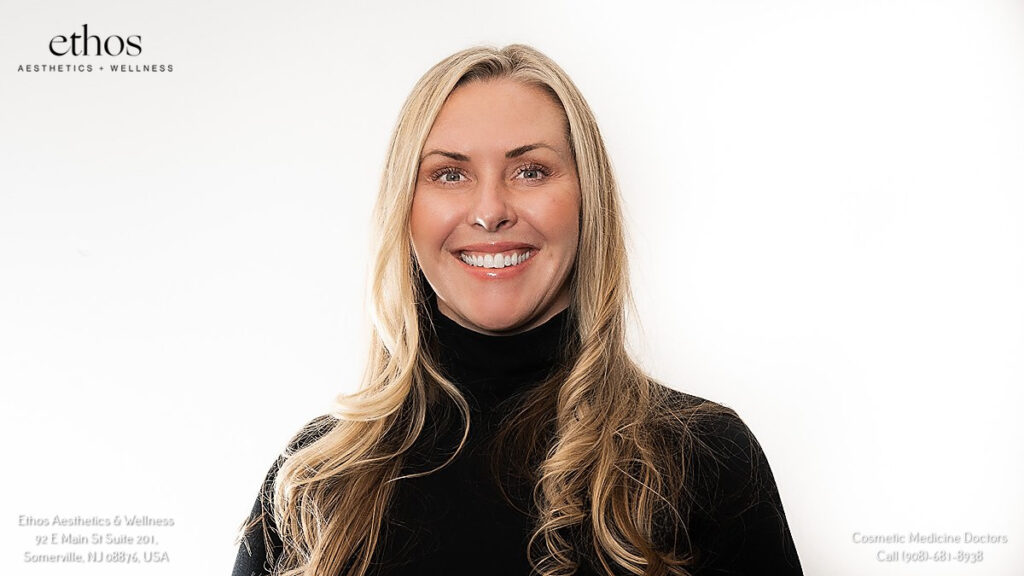
At Ethos Aesthetics + Wellness, your safety and satisfaction are our top concerns. Contact our office if you experience lip filler reactions so Dr. Soni can provide appropriate diagnosis and treatment. With prompt care, most reactions can be rapidly resolved.

